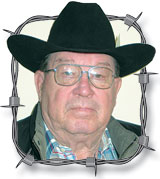As a tourist I’ve traveled hundreds of miles and paid gate fees to retrace the footsteps of Anasazi farmers in the American Southwest. I’ve seen desert clearings archaeologist tell us were cornfields, shallow ditches that carried water to the fields and the places where they stored, ground and cooked the corn in their pueblos and cliff dwellings.
Aided by historians’ images of how the ancient peoples dressed, in my mind’s eye I can see them working the fields, harvesting the corn and grinding the kernels into meal with smooth stones.
Satellite images from the heavens reveal the courses of ancient rivers and trade routes, and history comes alive through these evidences of vanished civilizations.
I find it all fascinating, but I don’t have to go to New Mexico or Arizona to see remnants of former agrarian societies. We are surrounded by relics of our own farming past. All we need do is open our eyes and minds to them.
I walk the fencerows and furrows of Ozarks history every time I cross an old farm within walking distance of my house. A sunken road is evidence of many wagons passing a spring known when only Osage crossed the prairie. Ridges in the black prairie earth betray the locations of old fencerows. Hidden in the overgrowth of briars and hedge sprouts, a rusted gate is entwined in vines and old barbed wire buried in the earth. Vagabond hedge posts mark fences not known for generations.
At the edge of a cornfield, almost invisible behind a hedge of weeds and briars, a three-bottom plow has been idled for ages; likewise, a spike harrow leans against the remnants of a fence. An abandoned trench silo lurks under a tangle of brush and trees.
At every turn is evidence of farming grandeur of earlier eras – roadways blocked by trees, mowers that draft horses once pulled locked in the growth of vines and sprouts.
It is a farm like hundreds of others in the Ozarks, its fencerows and overgrown waterways and corners harboring secrets of 150 years of farming.
In my mind’s eye I picture a farmer in overalls and a straw hat breaking ground with a team of big Missouri mules. I hear hogs fussing in a pen near the spring fed stream. I see a farm wife in a print dress feeding chickens and three youngsters bringing milk cows up a serpentine path from the west pasture. It’s a romantic image, and maybe not true, at all. But, it could be.
I’ve been an explorer of such places since childhood, starting with our own farm near Elkland, imagining wagons winding through our woods on an old road running southwest to northeast. I picture where the first house might have stood on a limestone foundation not far from an old well in the barn lot. Ridges in our lower fields mark the edges of ground once plowed and put into crops. Rocks piled alongside our hayfield speak of countless hours of labor to clear the land for farming. Even the eroded gullies we filled with brush shortly after moving to the place spoke of farming gone awry, but no evidence of them remains today.
Most Ozarks farms today include remnants of several places once settled and farmed by 19th century families. Old rock piles, ridges and foundation stones remain as evidence of their habitation, even if no buildings remain. Where no other relic may be found, neat rows of yellow jonquils might bloom in spring, reminding us some glade or corner was once a home where children’s voices filled the air, men and women labored to exact their livings from the earth and knelt daily to thank God he made them farmers and gave them a bit of ground to make their own.
They are historical treasures, each and every one, our old Ozarks farms, harboring secrets yet to be told, preserving unnumbered artifacts of agriculture in their fence rows and furrows.
We need not travel far to immerse ourselves in history, just the eyes and mind to see what lies at our feet.
A former feature writer for Ozarks Farm and Neighbor, Jim Hamilton is a retired editor/publisher of the Buffalo Reflex and continues to write a weekly column he began in the fall of 1978. Following retirement, he was inducted into the Missouri Press Association Hall of Fame. An alumnus of the Fair Grove FFA, Hamilton was reared on a small dairy farm in Dallas County, Mo. Contact Jim at [email protected]. Read more of his works in Ozarks RFD 2010-2015, available online from Amazon, Barnes & Noble or from the author.







